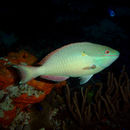en
names in breadcrumbs


Sparisoma aurofrenatum (common names: redband parrotfish, gutong, rainbow parrot, black parrot, and blisterside)[1] is a species of parrotfish native to the Caribbean Sea and Western Atlantic Ocean.[3]
This species grows to 28 cm.
During the initial phase, the colouration varies greatly from blue-green to green to solid olive. The fins are mottled brown to red and have two white stripes. Behind the dorsal fin, a white spot is present.[4]
The body of juvenile specimens are shades of red-brown. Normally, two white stripes will be visible with a black blotch present behind the upper gill covers. A white spot will also be present behind the dorsal fin.
During both the juvenile and initial phases, colouration and markings can change quickly.[4]
The body becomes greenish during the terminal phase. The underside will appear lighter and the anal fin becomes reddish. The tail becomes more square-shaped with black outer tips. The upper portion of the forebody will display a small, yellow blotch with at least two small black dots.
Normally, an orangish-pink[5] colour band will be present starting from below the eye along to the corner of the mouth. A white spot will appear behind the dorsal fin.[4]
This species occurs throughout the Caribbean Sea, and the western Atlantic Ocean in the waters of Bermuda, Florida, the Bahamas to Central America and Brazil.[2]
Sparisoma aurofrenatum lives on reefs in depths of 2 to 20 metres.[2] The juveniles live among seagrass beds.[6]
Sparisoma aurofrenatum is solitary or found in small groups. It may found resting on the bottom. It is a protogynous hermaphrodite.[2]
While swimming about reefs, this fish will use only its pectoral fins. Only when requiring a sudden burst of speed will it use its tail.[4]
Specimens may be seen defecating frequently, which appears as a white cloud as it is mostly composed of coral limestone.[4]
Sparisoma aurofrenatum is a herbivore, feeding on algae and polyps it scrapes from rocks and coral using its 'beak'.[7]
Sparisoma aurofrenatum (common names: redband parrotfish, gutong, rainbow parrot, black parrot, and blisterside) is a species of parrotfish native to the Caribbean Sea and Western Atlantic Ocean.